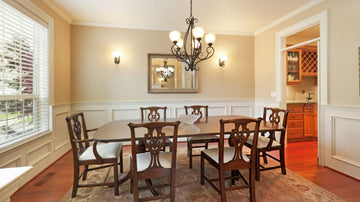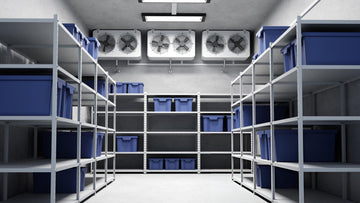Table of Contents
You’d think picking a dining chair would be all about the look—color, material, maybe if it matches the table. But here’s the thing: you don’t really notice the chair height... until it’s wrong.
Ever sat down and felt like you were sinking too low beneath the table edge? Or the opposite—like your knees barely fit and you’re hovering awkwardly over your plate? Yeah. It’s one of those “small” details that can totally throw off the whole eating experience.
Most dining chairs follow a pretty standard height range, but that doesn’t always mean it’s the right one for you—or your table. Some seats are padded and squishy, some are firm and high. Some tables are counter height, others are more traditional. It all adds up.
So if you're replacing chairs, mixing styles, or just trying to make your dining space feel better overall, getting the height right is one of the easiest wins. Let’s break down what to look for, what to avoid, and how to make sure your next chair doesn’t leave you sitting weird.

Aren’t All Dining Chairs the Same Height?
Not exactly. Most of them fall somewhere between 17 and 19 inches, measured from the floor up to the seat—not the back, just the part you sit on.
That range exists for a reason. It usually lines up with your average dining table, which is about 29 inches tall, give or take. It’s meant to give your legs room to move, let your arms rest naturally, and keep you from feeling like you’re either squatting or perched on a stool.
Still, that doesn’t mean it works for everyone.
If you’re tall, that “just right” chair might suddenly feel low. If you’re shorter, your feet might not even hit the floor all the way. Add in a cushion that squishes when you sit—or doesn’t move at all—and the whole thing changes.
Also, not every brand measures things the same way. Some include the padding, others don’t. And chairs with thick seats? They might look taller in the photo but feel lower when you actually sit down.
When in doubt, just measure a chair you already like and go from there. A quick check with a tape measure saves a lot of guesswork (and returns).
Your Table Height Kinda Decides Everything
You could have the coziest chair in the world—great back support, perfect seat depth—but if the table’s too high or too low? Yeah, it’s going to feel weird fast.
There’s this in-between space that matters way more than people think. Usually, people aim for about 10 to 12 inches between the seat and the tabletop. Not a strict rule, but it keeps things comfortable. Less than that and your thighs get squished. More than that and suddenly you feel like a kid again.
Most dining tables are around 29 inches tall, give or take. That’s why chairs in the 17–19 inch range usually work. It’s the combo you’ll see almost everywhere because… well, it works for most people.
But not all tables are created equal. Counter-height tables—like the ones people use in open kitchens or breakfast nooks—tend to be around 35 inches tall. For those, you’ll want taller chairs or low stools. Something closer to 24 or 26 inches high.
And then there’s bar-height. My friend has one of those tall tables in her apartment, and I swear, regular chairs look like doll furniture next to it. Those tables are way up there—like 40 to 42 inches—so you’ll need full-on bar stools. Think 28 to 30-inch seat height.
One thing to watch for that almost no one talks about? The under-table panel. That little strip of wood under the tabletop (the “apron”) can totally mess with your legroom. Everything might seem right on paper, but if your knees keep bumping, it’s not gonna work.

Height’s Just the Start—Let’s Talk Real Comfort
You can get the height technically right and still end up with a chair that just doesn’t feel good. That’s because comfort isn’t only about numbers—it’s about how you actually sit, move, and stay there for an entire meal (or let’s be honest, half your evening).
Let’s start with the seat itself. A firm wooden seat at 18 inches tall is going to feel way different from a soft, cushy upholstered one at the same height. Some cushions compress a lot when you sit, shaving off an inch or two. Others are basically bricks. So even if the measurements are identical, the way they feel? Totally different.
Then there’s the depth of the seat—like how far back you sit from the edge. If it’s too shallow, you feel like you’re perched on the edge of a bench. Too deep, and you’ll either slouch or end up with your legs dangling. Somewhere between 16 and 18 inches of seat depth tends to work for most people, but again, it depends.
Now, backrests. A good dining chair doesn’t need to be a recliner, but it should give you enough support so you’re not constantly adjusting your posture mid-dinner. High backs look elegant, but sometimes they can feel stiff or oversized, especially in smaller rooms.
What about armrests? They’re great for comfort, especially if you linger at the table after meals—but only if they actually fit under your table. If they bump the edge every time you pull the chair in, they’ll drive you nuts.
And finally, think about your body. There’s no such thing as a one-size-fits-all chair. What’s perfectly ergonomic for someone 5'2" might feel cramped to someone 6'1". If possible, try a few styles before committing—or at least read reviews from people with a similar build.

What Most People Get Wrong (Don’t Worry, It’s Fixable)
Not All Chairs Are Created Equal
People often assume dining chairs are more or less the same height. They're not. Just an inch or two of difference can mess with the way your table feels, especially if the table itself isn’t standard height.
Forgetting Cushion Compression
A chair might list its seat height as 18 inches, but if it has a super-soft cushion, you could sink down an inch or more. That’s the kind of thing you don’t notice until your elbows are suddenly below plate level.
Ignoring The Table Apron
That strip of wood (called the “apron”) under your tabletop can reduce leg space fast. Even if the chair should fit based on numbers, your knees might tell a different story. Always check for clearance—not just height.
Mixing Styles… But Not Measuring
Mismatched chairs can look great—but only if the seat heights line up. If one person is sitting noticeably higher or lower than the others, it’s going to feel off every time you eat together.
Only Measuring Once, Then Forgetting About It
Chairs aren’t just for quick meals. Sometimes you’re working at the table, helping kids with homework, or scrolling your phone for an hour. Think longer-term. What feels okay for 10 minutes might not hold up for 45.
Final Thoughts: Don’t Overlook the Inches
Chair height might not seem like a big deal at first. It’s just a couple inches, right?
But those inches decide whether you sit comfortably, whether your legs feel cramped, and whether dinner turns into a relaxed hangout or a constant shuffle in your seat.
Getting it right doesn’t mean memorizing a bunch of numbers. It means paying attention—to the table you already have, to how you actually sit, and to the small details like cushion softness or apron clearance that most people skip.
So before you hit “buy,” slow down. Measure your space. Compare with a chair that already feels good. Think about who’s using it, how long they’ll be sitting, and what else that chair might need to do—dining, working, scrolling, you name it.
Because when a chair fits just right, you don’t notice it. And that’s kind of the point.







